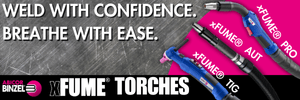Is It Time to Rebuild or Retrofit Your Hydraulic Press?
Hydraulic press operators must keep their costs down while meeting shorter lead times and the demand for higher precision parts. New press technology has already outdated some presses that were purchased as recently as ten to fifteen years ago. Is new machinery the only answer? Here’s why the answer is no.
Posted: February 20, 2013
Depending on PLC memory capacity, hundreds of programs can be stored that enable the press operator to change programs in just seconds and ensure that parts are produced precisely the same way each time they are run. Modern PLCs are also flexible enough to use multiple programming languages that best suit the current requirement.
Quality control is further improved with the use of bar code readers, a growing trend over the last five years. These readers can be used to scan the tool and work order to automatically upload the new parameters for that component. Scans can validate the press die against the work order to ensure the proper press is being used for the job. An employee’s badge can also be scanned to check for permission to operate the press.
New PLCs automate processes by controlling multiple presses within a line and/or integrating a press with auxiliary equipment. This allows a programmer to have consistent control over all press operations. Some typical applications include adding roll feeders that advance sheet metal in a press or integrating rotary index tables into a press.
Motors, much more efficient today than they were ten years ago, offer a reduced rotational mass and better quality copper for improved winding technology. Pumps are more efficient as well, including overall technological improvements and tighter tolerances in seals, more effective vanes, stronger hoses and couplings that virtually eliminate leaks and greatly minimize maintenance.
Even new additives in hydraulic fluids have increased effectiveness for better pump performance. With all of these improved components comes a reduced noise factor so that new pumps and motors run quieter. New components also reduce potential press downtime when a replacement part is in order because lead times to replace old components can take 12 weeks or more to source, whereas replacing a new off-the-shelf component is instant.
Press owners now have more options for their motor starters, including adding a soft starter or a variable frequency drive (VFD) that ramps up the rotation of the motor spindle to full speed and decreases the inrush current. A hydraulic press with a VFD starts the motor when the press is ready to do work, then turns it off when no movement of the platen is required, including any idle time on the press. This technology can run the motor at slower speeds during idle times to charge the accumulators and cool or filter the oil.
New options for increased press safety might include adding light curtain circuits, presence sensing devices, gates and barriers. Solid state relays for anti-tie downs on press buttons is another consideration.
PRESSING FOR CHANGE
Fabricators that determine they need some type of press upgrade must evaluate their goals in relationship to their costs. A reputable press manufacturer can be a pivotal resource during this evaluation process by helping the shop analyze their existing equipment and develop new design specifications while their existing press is still in operation – thus reducing downtime.
The following are checklists for helping to determine whether a retrofit or entire rebuild is most beneficial:
Retrofit /Upgrades
- Upgrade to the current ANSI B11.2-1995 (R2010) standards for safety
- Build in speed control for handling hard-to-form materials and increasing cycle rates
- Add closed-loop pressure and distance control
- Improve accuracy and repeatability
- Integrate automation components (robotics, feeders, etc.)
- Add the “ease-of-use” and accuracy of touch screen controls with recipe storage
- Build in the latest technology
Rebuilds
Rebuild services replace existing hydraulic, mechanical, and electrical components with new up-to-date components. If some of the following items are needed, it may be time for a rebuild.
- Replace old complex piping/valve systems with a single, consolidated, easy-to-troubleshoot manifold system.
- Replace or rebuild pumps and motors
- Replace leaky hydraulic pipe thread technology with Oil Ring Seals (ORS and SAE)
- Rewire electrical systems
- Rebuild cylinders
- Replace worn out platen guides/slides
- Strip down and repaint surfaces
- Replace ram gland rings and seals
- Total refurbishing
GOING GREEN FOR EFFICIENCY
The following is a good example of the benefits of a press rebuild: An automotive fabricator who purchased a HCA gap frame press in 1997 needed a press that was ANSI compliant and could provide all the quality, flexibility and maintenance advantages of modern technology.
This company determined that a full rebuild was in order based on their desire to utilize their existing equipment and the fact that rebuilding was somewhat less expensive than purchasing a new press. We replaced all the hydraulics and electrical components to a modern PLC, ANSI-compliant configuration. The only elements that stayed intact were the frame and steel components, which will last indefinitely.
A significant benefit was derived from synchronizing the two auxiliary side cylinders on the press. A master slave control on both sides uses servo quality proportional direction valves mounted directly to each cylinder to achieve a .001 in on position.
Prior to this rebuild, the operator was using hardened stop blocks to hit the hard stop. This older process is prone to error because after the press cycles, the parts may get out of tolerance and a manual positioning of the hard blocks was required. In terms of return on investment, this rebuild provided that shop with improved flexibility, consistent quality part runs and a set up that greatly reduced maintenance cycles.















